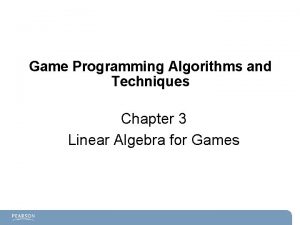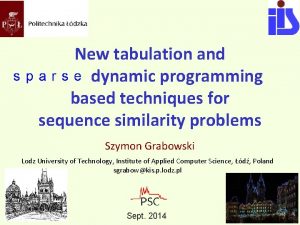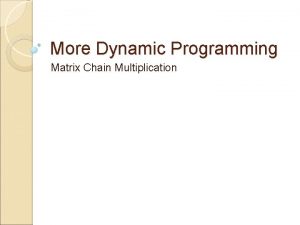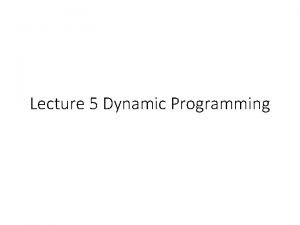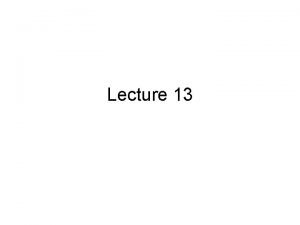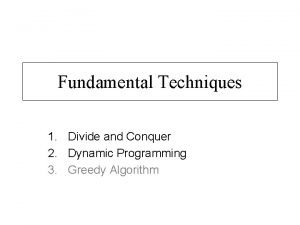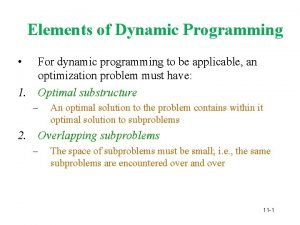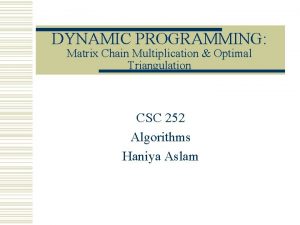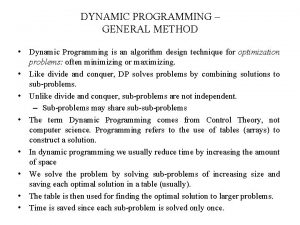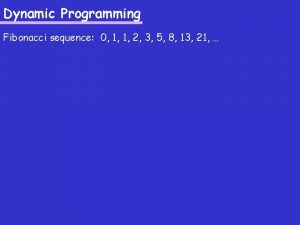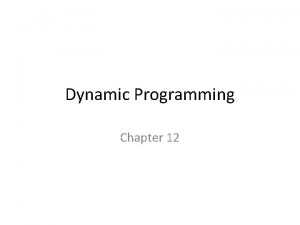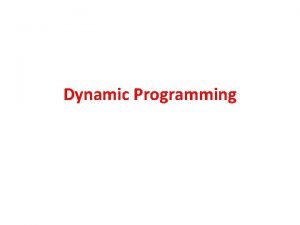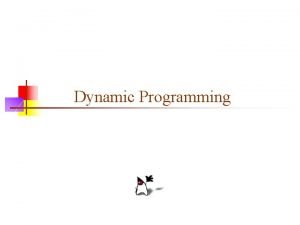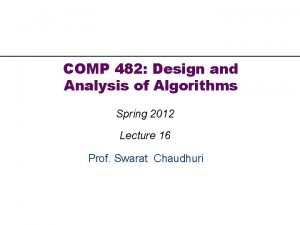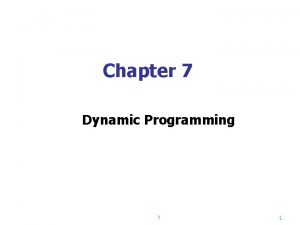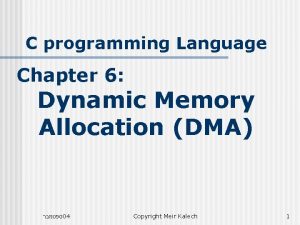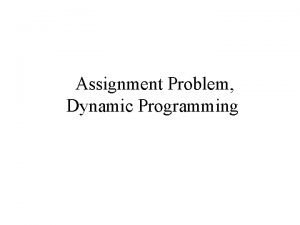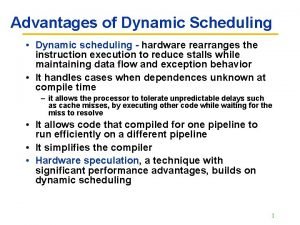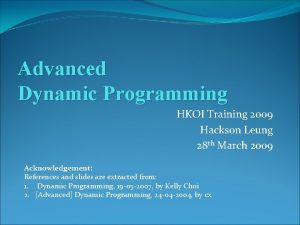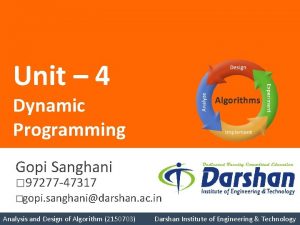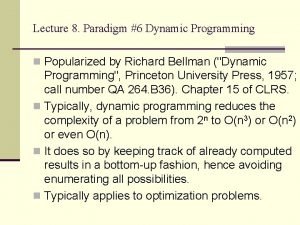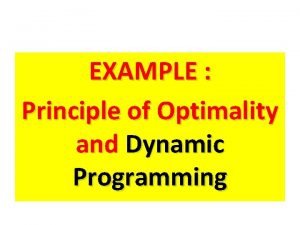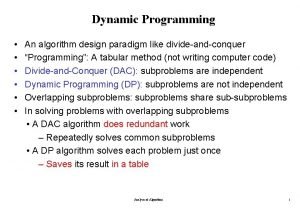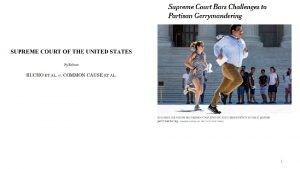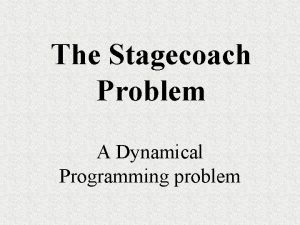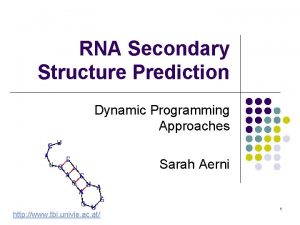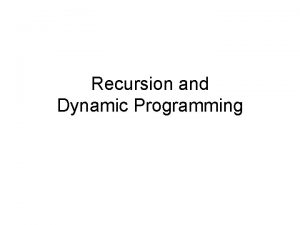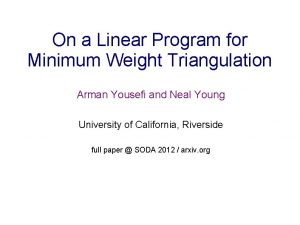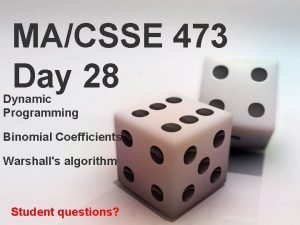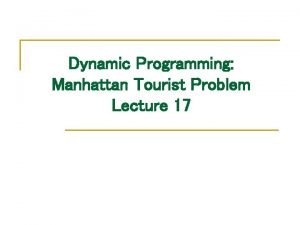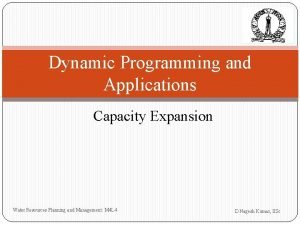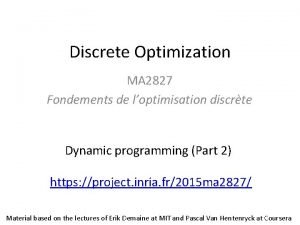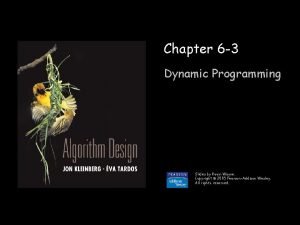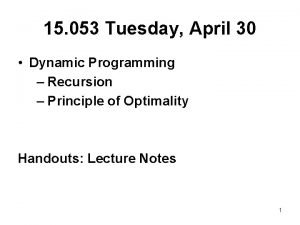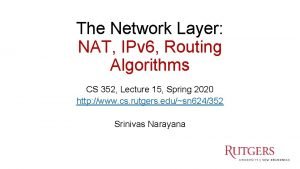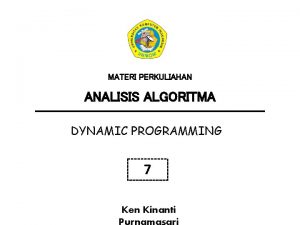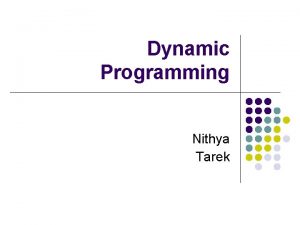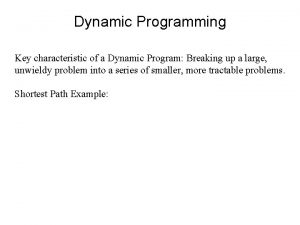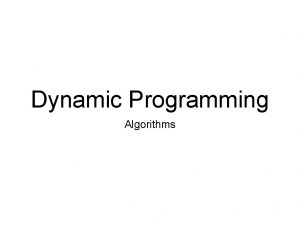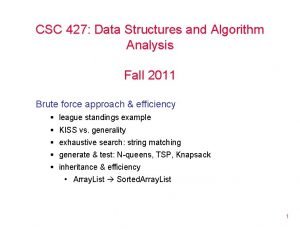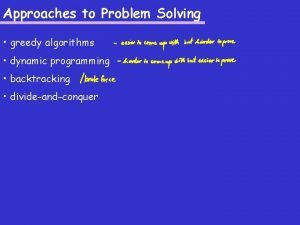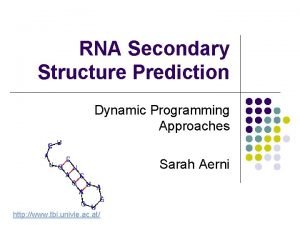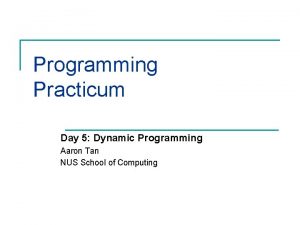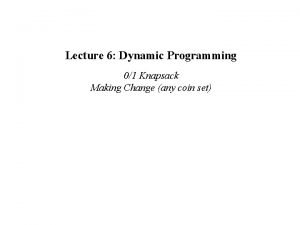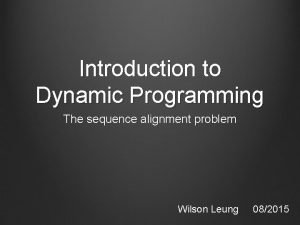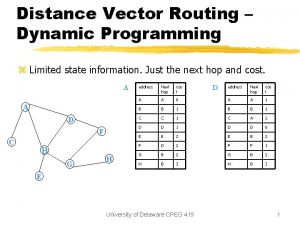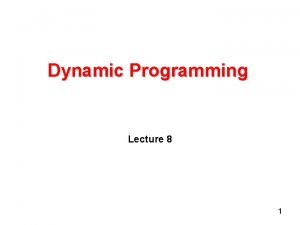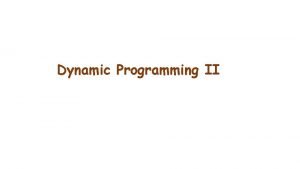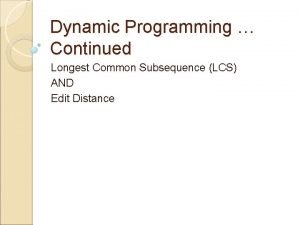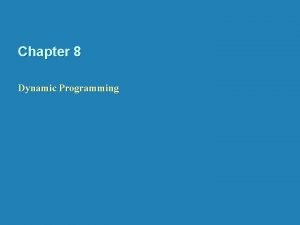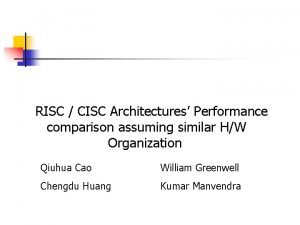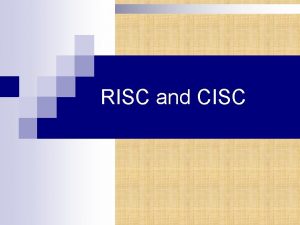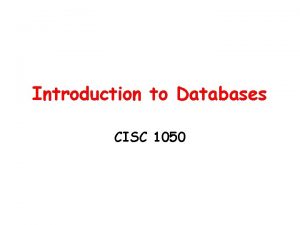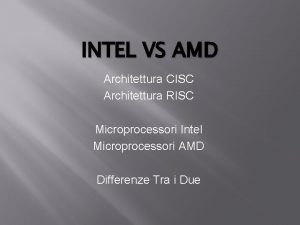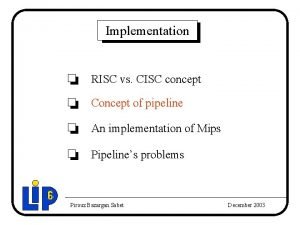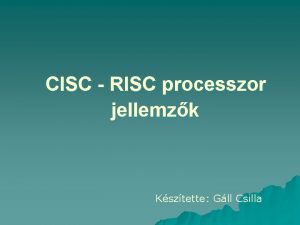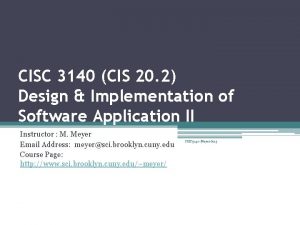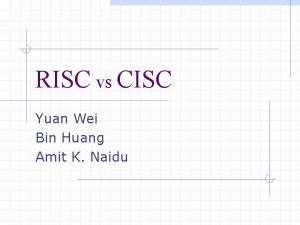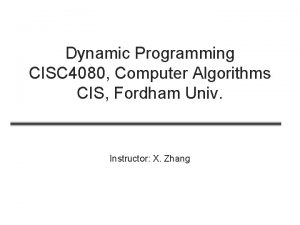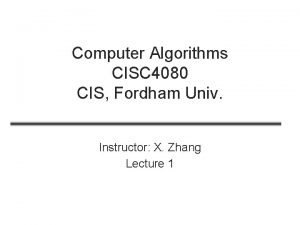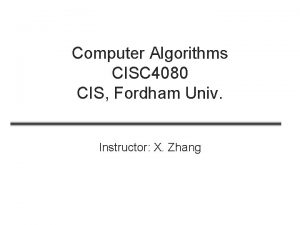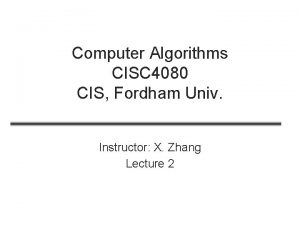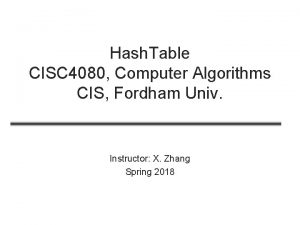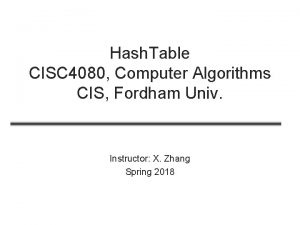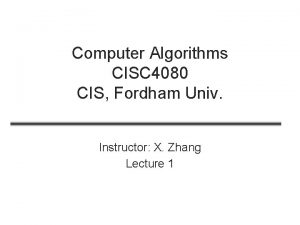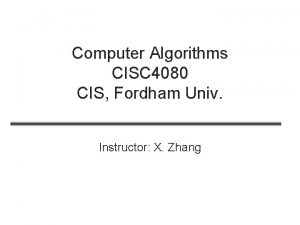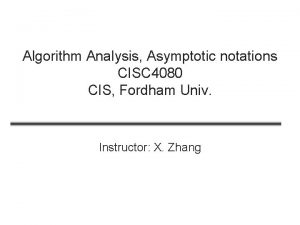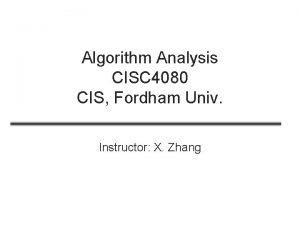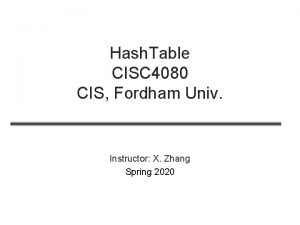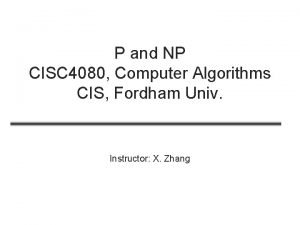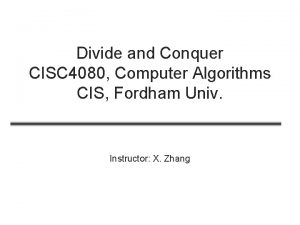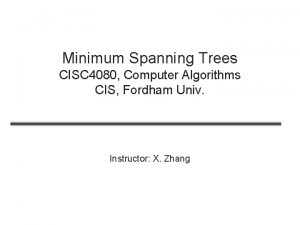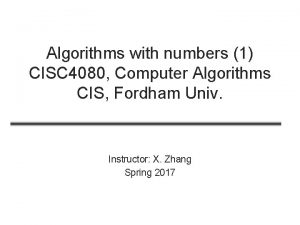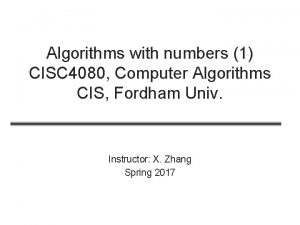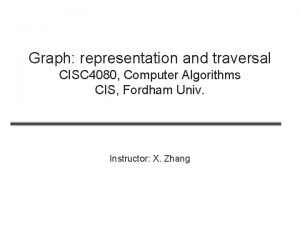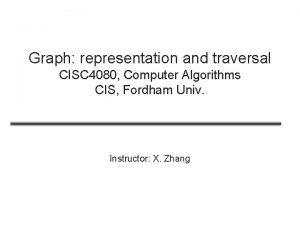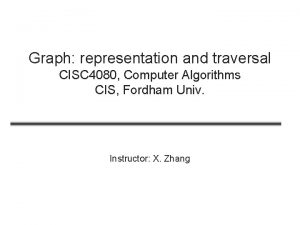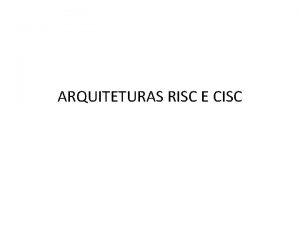Dynamic Programming CISC 4080 Computer Algorithms CIS Fordham




![Rod Cutting Problem • Input: • given rod’s length n • p[i]: selling price Rod Cutting Problem • Input: • given rod’s length n • p[i]: selling price](https://slidetodoc.com/presentation_image_h2/99d55a4bc2ead688965bd92c89f46688/image-5.jpg)


![Recursion! • • • Cut. Rod (n, p[1…k]) //return rn What’s the smallest problem(s) Recursion! • • • Cut. Rod (n, p[1…k]) //return rn What’s the smallest problem(s)](https://slidetodoc.com/presentation_image_h2/99d55a4bc2ead688965bd92c89f46688/image-8.jpg)
























![Analyze optimal solution • • A Index MSE(4)=4, array is A[4… 4] MSE(k) and Analyze optimal solution • • A Index MSE(4)=4, array is A[4… 4] MSE(k) and](https://slidetodoc.com/presentation_image_h2/99d55a4bc2ead688965bd92c89f46688/image-33.jpg)

![Idea to Pseudocode • Idea 1) Calculate MSE(1) … MSE(n) MSE(1)= A[1] MSE(i) = Idea to Pseudocode • Idea 1) Calculate MSE(1) … MSE(n) MSE(1)= A[1] MSE(i) =](https://slidetodoc.com/presentation_image_h2/99d55a4bc2ead688965bd92c89f46688/image-35.jpg)
![Running time Analysis int Max. Sub. Array (int A[1…n], int & start, int & Running time Analysis int Max. Sub. Array (int A[1…n], int & start, int &](https://slidetodoc.com/presentation_image_h2/99d55a4bc2ead688965bd92c89f46688/image-36.jpg)






















![Knapsack_Norepeat (W, w, v, n) { initialize V[W+1][n+1] to store solutions to subproblems // Knapsack_Norepeat (W, w, v, n) { initialize V[W+1][n+1] to store solutions to subproblems //](https://slidetodoc.com/presentation_image_h2/99d55a4bc2ead688965bd92c89f46688/image-59.jpg)




![Brute-Force Solution 1. /* Check every subsequence of X[1. . m] to see if Brute-Force Solution 1. /* Check every subsequence of X[1. . m] to see if](https://slidetodoc.com/presentation_image_h2/99d55a4bc2ead688965bd92c89f46688/image-64.jpg)


![Recursive Solution. Case 2 if X[m] ¹ Y[n] e. g. : X = áA, Recursive Solution. Case 2 if X[m] ¹ Y[n] e. g. : X = áA,](https://slidetodoc.com/presentation_image_h2/99d55a4bc2ead688965bd92c89f46688/image-67.jpg)







![Bottom-Up 0 Y Initialization: base c[i, j] = 0 if i=0, or j=0 0 Bottom-Up 0 Y Initialization: base c[i, j] = 0 if i=0, or j=0 0](https://slidetodoc.com/presentation_image_h2/99d55a4bc2ead688965bd92c89f46688/image-75.jpg)
![Dynamic-Programming Algorithm Reconstruct LCS tracing backward: Where do we get value of C[i, j] Dynamic-Programming Algorithm Reconstruct LCS tracing backward: Where do we get value of C[i, j]](https://slidetodoc.com/presentation_image_h2/99d55a4bc2ead688965bd92c89f46688/image-76.jpg)







- Slides: 83

Dynamic Programming CISC 4080, Computer Algorithms CIS, Fordham Univ. Instructor: X. Zhang

Outline • Introduction via example: Fibonacci, rod cutting • Characteristics of problems that can be solved using dynamic programming • More examples: • Maximal subarray problem • Longest increasing subsequence problem • Two dimensional problem spaces • Longest common subsequence • Matrix chain multiplication 2

Dynamic Programming 3

Rod Cutting Problem • A company buys long steel rods (of length n), and cuts them into shorter one to sell • integral length only • cutting is free • rods of diff lengths sold for diff. price • Goal: cut rod into shorter ones to sell for maximal profit 4
![Rod Cutting Problem Input given rods length n pi selling price Rod Cutting Problem • Input: • given rod’s length n • p[i]: selling price](https://slidetodoc.com/presentation_image_h2/99d55a4bc2ead688965bd92c89f46688/image-5.jpg)
Rod Cutting Problem • Input: • given rod’s length n • p[i]: selling price of rod of length i, for example: • Output: maximal achievable total settling price, Rn, over all possible ways to cut out n to shorter pieces and sell • For example, if n=4, we could cut it into: • • • {4}: do not cut ==> total selling price is $9 {3, 1} ==> selling price $8+$1=$9 {2, 2} ==> $10 multiset: {2, 1, 1} ==> $7 allow duplicate elements order does not matter {1, 1, 1, 1}==> $4 5

Solution Space • Evaluate all possible ways, and pick one with highest total selling price? • how many ways to write n as sum of positive integers? • n=4, there are 5 ways: 4=4, 4=1+3, 4=2+2, 4=1+1+1+1, 4=2+1+1 • n=5: … • # of ways to cut n: # of ways to express n as positive integer linear combination of 1, 2, … 10, • this leads to exponential running time 6

Thinking Recursively • //return maximum profit achievable with a rod of length n • Cut. Rod (n, p[1…k]) • What’s the smallest problem(s) that we can solve trivially? • if n=0, n=1 • How to reduce the problem to smaller problems? 7
![Recursion Cut Rod n p1k return rn Whats the smallest problems Recursion! • • • Cut. Rod (n, p[1…k]) //return rn What’s the smallest problem(s)](https://slidetodoc.com/presentation_image_h2/99d55a4bc2ead688965bd92c89f46688/image-8.jpg)
Recursion! • • • Cut. Rod (n, p[1…k]) //return rn What’s the smallest problem(s) that we can solve trivially? • if n=0, n=1 How to reduce the problem to smaller problems? • consider the first rod to cut out and sell, c 1 • c 1 can be 1, 2, 3, … , min (n, k) • we sell it for p[c 1], and have a rod of length n-c 1 remaining ==> a smaller problems • Just try all different c 1 and solve subproblems recursively: 8

Optimal substructure • Optimal substructure: Optimal solution to a problem of size n incorporates optimal solutions to problems of smaller size (n-1, n-2, … ). 9

Optimal Substructure => recursive solution • //return max. profit one can make with a rod of length n • Cut. Rod (n, p[1…k]) //What’s the smallest problem(s) that we can solve trivially? if n=0 return 0 if n=1 return p[1] //general case: consider the first rod to cut out and sell, cur. Max=0 for c 1=1, 2, 3, … , min (n, k) cur. Profit = p[c 1]+Max. Prof (n-c 1) cur. Max = max (cur. Profit, cur. Max) // done evaluating all possibilities return cur. Max 10

Running time? • //return max. profit one can make with a rod of length n • Cut. Rod (n, p[1…k]) //What’s the smallest problem(s) that we can solve trivially? if n=0 return 0 // for n > k if n=1 return p[1] //general case: consider the first rod to cut out and sell, cur. Max=0 for c 1=1, 2, 3, … , min (n, k) cur. Profit = p[c 1]+Cut. Rod (n-c 1) cur. Max = max (cur. Profit, cur. Max) // done evaluating all possibilities return cur. Max 11

Recursive Trees How many times Cut. Rod (2) is called? How about Cut. Rod(1)? 12

Overlapping of Subproblems • Recursive calling tree shows overlapping of subproblems • i. e. , n=4 and n=3 share overlapping subproblems (2, 1, 0) • Idea: avoid recomputing subproblems again and again • store subproblem solutions in memory/table (hence “programming”) 13

Dynamic Programming: two approach • memoization (recursive, top-down) • improve recursive solution by storing subproblem solution in a table • when need solution of a subproblem, check if it has been solved before, • if not, calculate it and store result in table • if yes, access result stored in table • a top-down approach: • start with the problem at hand (a larger problem), and solve subproblems as needed (recursively)

Memoization illustrated in code //return max. profit one can make with a rod of length n Cut. Rod (n, p[1…k]) 1. create an array r[1…n], filled with -1 (indicate “not calculated yet”) 2. Cut. Rod. Helper (n, p, r) Cut. Rod. Helper (n, p[1…k], r[]) 1. if r[n] >=0 return r[n] //if it has been calculated already 2. // no need to recalculate, return the stored result 3. 4. if n==0 return 0 //base case 5. //general case 6. cur. Max=0 7. for c 1=1, 2, 3, … , min (n, k) 8. cur. Profit = p[c 1] + Cut. Rod. Helper (n-c 1) 9. cur. Max = max(cur. Profit, cur. Max) 10. 11. r[n]= cur. Max //save result in r[] for future reference 12. return cur. Max 15

Dynamic Programming: Tabulation • Memoization (recursive, top-down) • Tabulation • Iteratively solve smaller problems first, move the way up to larger problems • bottom-up method: as we solve smaller problems first, and then larger and larger one • => when solving a problem, all subproblems solutions that are needed have already been calculated

Bottom-up • //return max. profit one can make with a rod of length n • Cut. Rod. Bottom. Up (n, p[1…k]) 1. create an array r[1…n] //store subproblem solutions 2. r[0] = 0 3. for i=1 to n // solve smaller problems first … 4. // calculate ri , max revenue for rod length i 5. cur. Max=0 6. for c 1=1, 2, 3, … , min (i, k) 7. cur. Profit = p[c 1]+ r[i-c 1] 8. cur. Max = max(cur. Profit, cur. Max) 9. r[i]= cur. Max //save result in r[] for future reference 10. 11. return r[n] 17

Recap • • We analyze rod cutting problem Two characteristics of problems that can benefit from dynamic programming: • optimal substructure: a recursive formular • overlapping subproblems 18

Recap (2) • How dynamic programming works: • Memoization: recursion with table • Tabulation: iteratively solve all possible subproblems, and work our way from small problems to large problems 19

Exercises • Copy given C++ program for rod cutting • copy. Rod. Cut • cd Cut. Rod; Compile and run • Exercise #1: • add some cout statement to find out how many times Max. Prof (3) is called when Max. Prof(6) is called from main. • Exercise #2: • So far, we focus on finding , max. revenue… • but what cutting achieves ? • How to extend the functions to output/return the cutting? • e. g. , n=4, cutting 2, 2, r_4=… 20

Tracing: Cut. Rod(n=3, p) //return max. profit one can make with a rod of length n Cut. Rod (n, p[1…k]) 1. create an array r[1…n], filled with -1 (indicate “not calculated yet”) 2. Cut. Rod. Helper (n, p, r) Tracing with n=3 table r : Cut. Rod. Helper (n, p[1…k], r[]) 1. if r[n] >=0 return r[n] //if it has been calculated already c 1 cur. Profit 2. // no need to recalculate, return the stored result cur. Max 3. 4. if n==0 return 0 //base case 5. //general case 6. cur. Max=0 7. for c 1=1, 2, 3, … , min (n, k) 8. cur. Profit = p[c 1] + Cut. Rod. Helper (n-c 1) 9. cur. Max = max(cur. Profit, cur. Max) 10. 11. r[n]= cur. Max //save result in r[] for future reference 12. return cur. Max 21

Tabulation: Tracing n=5 • //return max. profit one can make with a rod of length n • Cut. Rod. Bottom. Up (n, p[1…k]) 1. create an array r[1…n] //store subproblem solutions 2. r[0] = 0 3. for i=1 to n // solve smaller problems first … 4. // calculate ri , max revenue for rod length i 5. cur. Max=0 6. for c 1=1, 2, 3, … , min (i, k) 7. cur. Profit = p[c 1]+ r[i-c 1] 8. cur. Max = max(cur. Profit, cur. Max) 9. r[i]= cur. Max //save result in r[] for future reference 10. 11. return r[n] 22

Discussion: Knapsack • Input • given weight capacity of a knapsack, W • n different objects, with weights and values given by array w[ ], v[ ] • • i-th type of objects weighs w[i] and has a value of v[i] there are infinite quantities of each object type • Output: objects to put into knapsack so that total value is maximized and total weights <= W • For now, focus on max. total value • Discussion: • how is this similar to Rod Cutting? 23

Discussion: Knapsack • Input: weight capacity of a knapsack, W; n different objects, with weights and values given by array w[ ], v[ ] • i-th type of objects weighs w[i] and has a value of v[i] • there are infinite quantities of each object type • Output: objects to put into knapsack so that total value is maximized and total weights <= W • For example: W=13, w[4]={5, 3, 8, 4}, v[4]={10, 25, 8} in the figure • Let Vk be max total value possible when weight capacity is k • V 13 = ? Consider first object to put in knapsack: • if object #1 => total max. value would be 10 + max value possible with 13 -5 • if object #2 => total max. value would be …. • if object #i => total max. value would be What would be V 13? 24

Optimal substructure in Knapsack • Input: weight capacity of a knapsack, W; n different objects (of infinite quantities) with weights and values given by array w[ ], v[ ] • Output: objects so that total value is maximized and total weights <= W • For example: W=13, w[4]={5, 3, 8, 4}, v[4]={10, 25, 8} in the figure • Let Vk be max total value possible when weight capacity is k • Recursive formula for Vk • A illustration of calculation of W 13 • Run the following command to copy the sample code: copy. Rod. Cut 25

Knapsack: extension • Input: weight capacity of a knapsack, W; n different objects (of infinite quantities) with weights and values given by array w[ ], v[ ] • Output: objects so that total value is maximized and total weights <= W • Let Vk be max total value possible when weight capacity is k • What’s the set of objects (multi-set) that achieve Vk? • The i that achieves the max value above • and then the object i 1 chosen for k-w[i] • and then the object i 2 chosen for k-w[i]-w[i 1] • … until the weight capacity ==0 or < min(w) a table obj[]: obj[k] store the first object to chose when capacity is k (the one that maximize …) Output the multi-set achieving Vk, using obj[ ] array Demo… • • • 26

Discussion(2) • Cutting cloth to make products. How to maximize profit? 27

Outline • • Introduction via example: rod cutting Characteristics of problems that can be solved using dynamic programming • More examples: • Maximal subarray problem • Longest increasing subsequence problem • Two dimensional problem spaces • Longest common subsequence • Matrix chain multiplication • Summary 28

maximum (contiguous) subarray • • Problem: find contiguous subarray within an array (containing at least one number) which has largest sum • If given the array [-2, 1, -3, 4, -1, 2, 1, -5, 4], • contiguous subarray [4, -1, 2, 1] has largest sum = 6 Brute-force? • brute-force: n 2 or n 3 Divide-and-conquer: T(n)=2 T(n/2)+O(n), T(n)=nlogn Dynamic programming? 29

Analyze optimal solution • Problem: find contiguous subarray with largest sum • • Sample Input: [-2, 1, -3, 4, -1, 2, 1, -5, 4] (array of size n=9) How does solution to this problem relates to smaller subproblem? • If we divide up array into two halves • [-2, 1, -3, 4, -1, 2, 1, -5, 4] //find Max. Sub in this array • • [-2, 1, -3, 4, -1] [2, 1, -5, 4] • still need to consider subarray that spans both halves • This does not lead to a dynamic programming sol. Need a different way to define smaller subproblems! 30

Analyze optimal solution • Problem: find contiguous subarray with largest sum A Index • MSE(k), max. subarray ending at pos k, among all subarray ending at k (A[i…k] where i<=k), the one with largest sum • • MSE(1), max. subarray ending at pos 1, is A[1. . 1], sum is -2 MSE(2), max. subarray ending at pos 2, is A[2. . 2], sum is 1 MSE(3) is A[2. . 3], sum is -2 MSE(4)? 31

Analyze optimal solution • • • A Index MSE(k) and optimal substructure • • MSE(3): A[2. . 3], sum is -2 (red box) MSE(4): two options to choose How a problem’s optimal • (1) either grow MSE(3) to include pos 4 solution can be derived from optimal solution to smaller • subarray is then A[2. . 4], sum is MSE(3)+A[4]=problem 2+A[4]=2 • (2) or start afresh from pos 4 • subarray is then A[4… 4], sum is A[4]=4 (better) • Choose the one with larger sum, i. e. , • MSE(4) = max (A[4], MSE(3)+A[4]) 32
![Analyze optimal solution A Index MSE44 array is A4 4 MSEk and Analyze optimal solution • • A Index MSE(4)=4, array is A[4… 4] MSE(k) and](https://slidetodoc.com/presentation_image_h2/99d55a4bc2ead688965bd92c89f46688/image-33.jpg)
Analyze optimal solution • • A Index MSE(4)=4, array is A[4… 4] MSE(k) and optimal substructure • Max. subarray ending at k is the larger between A[k…k] and Max. subarray ending at k-1 extended to include A[k] MSE(k) = max (A[k], MSE(k-1)+A[k]) • MSE(5)= , subarray is • MSE(6) • MSE(7) • MSE(8) • MSE(9) 33

Analyze optimal solution • A • Index • Once we calculate MSE(1) … MSE(9) • MSE(1)=-2, the subarray is A[1. . 1] • MSE(2)=1, the subarray is A[2. . 2] • MSE(3)=-2, the subarray is A[2. . 3] • MSE(4)=4, the subarray is A[4… 4] • … MSE(7)=6, the subarray is A[4… 7] • MSE(9)=4, the subarray is A[9… 9] • What’s the maximum subarray of A? • well, it either ends at 1, or ends at 2, …, or ends at 9 • Whichever yields the largest sum! 34
![Idea to Pseudocode Idea 1 Calculate MSE1 MSEn MSE1 A1 MSEi Idea to Pseudocode • Idea 1) Calculate MSE(1) … MSE(n) MSE(1)= A[1] MSE(i) =](https://slidetodoc.com/presentation_image_h2/99d55a4bc2ead688965bd92c89f46688/image-35.jpg)
Idea to Pseudocode • Idea 1) Calculate MSE(1) … MSE(n) MSE(1)= A[1] MSE(i) = max (A[i], A[i]+MSE(i-1)); 2) Return max of MSE(i), for i=1, 2, …n int Max. Sub. Array (int A[1…n], int & start, int & end) { // Use array MSE to store the MSE(i) MSE[1]=A[1]; max. Sub. Array = MSE[1]; //use tabulation/bottom up to calculate MSE for (int i=2; i<=n; i++) { MSE[i] = ? ? max. Sub. Array = max(max. Sub. Array, MSE[i]); } return max. Sub. Array; Practice: 1) fill in ? ? } 2) How to find out starting and ending index of the max. subarray? 35
![Running time Analysis int Max Sub Array int A1n int start int Running time Analysis int Max. Sub. Array (int A[1…n], int & start, int &](https://slidetodoc.com/presentation_image_h2/99d55a4bc2ead688965bd92c89f46688/image-36.jpg)
Running time Analysis int Max. Sub. Array (int A[1…n], int & start, int & end) { // Use array MSE to store the MSE(i) MSE[1]=A[1]; max_MSE = MSE[1]; for (int i=2; i<=n; i++) { MSE[i] = ? ? if (MSE[i] > max_MSE) { max_MSE = MSE[i]; } } return max_MSE; • • • It’s easy to see that running time is O(n) • a loop that iterates for n-1 times Recall other solutions: • brute-force: n 2 or n 3 • Divide-and-conquer: nlogn Dynamic programming wins! } 36

What is DP? When to use? • We have seen several optimization problems • brute force solution • divide and conquer • dynamic programming • To what kinds of problem is DP applicable? • • Optimal substructure: Optimal solution to a problem of size n incorporates optimal solution to problem of smaller size (1, 2, 3, … n-1). Overlapping subproblems: small subproblem space and common subproblems 37

Optimal substructure • • Optimal substructure: Optimal solution to a problem of size n incorporates optimal solution to problem of smaller size (1, 2, 3, … n-1). Rod cutting: find rn (max. revenue for rod of len n) Sol to problem instance of size n-1, n-2, … 1 rn = max (p[1]+rn-1, p[2]+rn-2, p[3]+rn-3, …, p[n-1]+r 1, p[n]) • A recurrence relation (recursive formula) • => Dynamic Programming: Build an optimal solution to the problem from solutions to subproblems • We solve a range of sub-problems as needed 38

Optimal substructure in Max. Subarray Problem • Optimal substructure: Optimal solution to a problem of size n incorporates optimal solution to problem of smaller size (1, 2, 3, … n-1). • Max. Subarray Problem: • MSE(i) = max (A[i], MSE(i-1)+A[i]) Max. Subarray Ending at position i is the either the max. subarray ending at pos i-1 extended to pos i; or just A[i] • Max Subarray = max (MSE(1), MSE(2), …MSE(n)) 39

Overlapping Subproblems • space of subproblems must be “small” • • • DP algorithms take advantage of this property • • • total number of distinct subproblems is a polynomial in input size (n) a recursive algorithm revisits same problem repeatedly, i. e. , optimization problem has overlapping subproblems. solve each subproblem once, store solutions in a table Look up table for sol. to repeated subproblem using constant time per lookup. In contrast: divide-and-conquer solves new subproblems at each step of recursion. 40

Outline • • Introduction via example: rod cutting Characteristics of problems that can be solved using dynamic programming • More examples: • Maximal subarray problem • Longest increasing subsequence problem • Two dimensional problem spaces • Longest common subsequence • Matrix chain multiplication • Summary 41

Longest Increasing Subsequence • • Input: a sequence of numbers given by an array a Output: a longest subsequence (a subset of the numbers taken in order) that is increasing (ascending order) • Example, given a sequence • 5, 2, 8, 6, 3, 6, 9, 7 • There are many increasing subsequence: 5, 8, 9; or 2, 9; or 8 • The longest increasing subsequence is: 2, 3, 6, 9 (length is 4) 42

LIS as a DAG • Find longest increasing subsequence of a sequence of numbers given by an array a 5, 2, 8, 6, 3, 6, 9, 7 Observation: • If we add directed edge from smaller number to larger one, we get a DAG. • A path (such as 2, 6, 7) connects nodes in increasing order 43 • LIS corresponds to longest path in the graph.

Graph Traversal for LIS • Find longest increasing subsequence of a sequence of numbers given by an array a 5, 2, 8, 6, 3, 6, 9, 7 Observation: • LIS corresponds to longest path in DAG • Finding Longest path in a general graph is a hard problem 44

Dynamic Programming Sol: LIS • Find Longest Increasing Subsequence of a sequence of numbers given by an array a 1 2 3 4 5 6 7 8 Let L(n) be the length of LIS ending at n-th number L(1) = 1, LIS ending at pos 1 is 5 L(2) = 1, LIS ending at pos 2 is 2 L(7)= // how to relate to L(1), …L(6)? • Consider LIS ending at a[7] (i. e. , 9). What’s the number before 9? . … ? , 9 45

Dynamic Programming Sol: LIS • Given a sequence of numbers given by an array a 1 2 3 4 5 6 7 8 Let L(n) be length of LIS ending at n-th number Consider all increasing subsequence ending at a[7] (i. e. , 9). • What’s the number before 9? • It can be either NULL, or 6, or 3, or 6, 8, 2, 5 (all those numbers pointing to 9) • If the number before 9 is 3 (a[5]), what’s max. length of this seq? L(5)+1 where the seq is …. 3, 9 LIS ending at pos 5 46

Dynamic Programming Sol: LIS • Given a sequence of numbers given by an array a Pos: 1 2 3 4 5 6 7 8 Let L(n) be length of LIS ending at n-th number Consider all increasing subsequence ending at a[7] (i. e. , 9). • It can be either NULL, or 6, or 3, or 6, 8, 2, 5 (all those numbers pointing to 9) • L(7)=max(1, L(6)+1, L(5)+1, L(4)+1, L(3)+1, L(2)+1, L(1)+1) • L(8)=? 47

Dynamic Programming Sol: LIS • Given a sequence of numbers given by an array a Pos: 1 2 3 4 5 6 7 8 Let L(n) be length of LIS ending at n-th number. Recurrence relation: Note that the i’s in RHS is always smaller than the j • How to implement? Running time? • LIS of sequence = Max (L(i), 1<=i<=n) // the longest among all 48

Outline • • Introduction via example: rod cutting Characteristics of problems that can be solved using dynamic programming • More examples (skipped) • Maximal subarray problem • Longest increasing subsequence problem • Two dimensional problem spaces • Add up to N problem • Knapsack with one of each • Longest common subsequence • Matrix chain multiplication • Summary 49

K-Sum Problem (add up to K) • Problem: Given an array of int values and integer K, find out whethere is a subset of these numbers that add up to K (and output one such subset) • cannot use a number multiple times • bool Add. Up. To. K (int numbers[], int n, int K) • K=100, n=9, numbers: 22 34 18 30 76 1 3 1 2 3 4 5 6 19 80 7 8 9 • In lab 2: 1) use binary number to enumerate all 2 n subsets, 2) use recursive function to check all possible subsets (include numbers[i] or not) • Now: use dynamic programming to improve recursive solution 50

K-Sum Problem (add up to K) • Problem: find out whethere is a subset of these numbers that add up to K (and output one such subset) • bool Add. Up. To. K (int numbers[], int num_len, int K) • K=100, num_len=9 numbers: 1 • Think recursively! • base case: 2 3 4 5 6 7 8 9 22 34 18 30 76 1 3 19 80 • general case: how to reduce it to smaller problem(s)? • hint: recall how we did it in Knapsack and Rod. Cut? 51

K-Sum Problem (add up to K) • Problem: find out whethere is a subset of these numbers that add up to K (and output one such subset) • bool Add. Up. To. K (int numbers[], int num_len, int K) • K=100, num_len=9 numbers: 1 2 3 4 5 6 7 8 9 22 34 18 80 76 1 3 19 20 • base cases • if K==0 return true • if K>0 and num_len==0 return false • general case: //how reduce to smaller problem? • • consider making one decision: include last number, 20, or not? if included it, then see if we can add up to 100 -20 using the rest of the numbers • if not, see if we can add up to 100 using the rest of the numbers. • two subproblems (underlined above) 52

K-Sum Problem (add up to K) Problem: find out whethere is a subset of these numbers that add up to K (and output one such subset) bool Add. Up. To. K (int numbers[], int num_len, int K) 1 2 3 4 5 6 7 8 9 { //base cases 22 34 18 80 76 1 3 19 20 if K==0 return true if K>0 and num_len==0 return false // general case: consider include last number, 20 (in this case), or not? if (Add. Up. To. K (numbers, num_len-1, K-numbers[num_len-1])) return true; //we can make K by including last num… else if (Add. Up. To. K (numbers, num_len-1, K)) return true; //we can make K by not including last num else return false; //not possible } 53

K-Sum Problem (add up to K) • Problem: find out whethere is a subset of these numbers that add up to K (and output one such subset) • bool Add. Up. To. K (int numbers[], int num_len, int K) • K=100, num_len=9 numbers: 1 2 3 4 5 6 7 8 9 22 34 18 80 76 1 3 19 20 • Overlapping subproblems? • can you give an example of overlapping subproblems? • sol: • if we include 20, but not 19, 3, 1, 76 => Add. Up. To. K(… 4, 80) //use numbers[1… 4] to make 80 • if we include 19, 1 and not 20, 3, 76 => Add. Up. To. K(…, 4, 80): same subproblems 54

K-Sum Problem (add up to K) • Problem: find out whethere is a subset of these numbers that add up to K (and output one such subset) • bool Add. Up. To. K (int numbers[], int num_len, int K) • K=100, num_len=9 numbers: 1 2 3 4 5 6 7 8 9 22 34 18 80 76 1 3 19 20 • Overlapping subproblems? • can you give an example of overlapping subproblems? • sol: • if we include 20, but not 19, 3, 1, 76 => Add. Up. To. K(… 4, 80) //use numbers[1… 4] to make 80 • if we include 19, 1 and not 20, 3, 76 => Add. Up. To. K(…, 4, 80): same subproblems • Memoization or Tabulation: store subproblem solutions 55

K-Sum Problem: tabulation /*whethere is a subset of these numbers that add up to K, and output one such subset */ bool Add. Up. To. K_Tabulation (int numbers[], int num_len, int K) { bool C[K+1][num_len+1]; // C[k][n]: can we add up to k using numbers[1…n] 1 2 3 4 5 6 7 8 9 for n=0 to num_len C[0][n] = 0 // if K==0 return true 22 34 18 80 76 1 3 19 20 for k=1 to K C[k][0] = false //fill in array row by row, left to right for k=1 to K for n=1 to num_len if C[k][n-1]==true C[k][n]=true //we can make k without last number //otherwise, can we include numbers[n] to make k? else if k==numbers[n] C[k][n] = true; else if k>numbers[n] and C[k-numbers[n]][n-1]==true C[k][n] = true; else //k<numbers[n] or cannot make k-numbers[n] using numbers[1…n-1] C[k][n] = false return C[K][num_len]; 56

Knapsack without repetition • Input: given weight capacity of a knapsack, W; and n different objects, with weights and values given by array w[ ], v[ ] • • there is one of each type object: one gold bar, one diamond… finding a subset of objects … • Output: objects to select so that total value is maximized and total weights <= W • We could enumerate all possible subsets (as in lab 2) • => Running time • Plan: • recursive solution • use memoization or tabulation to improve 57

/* Output max. value, and objects to select @param W: given weight capacity, >=0 @ param n: # of objects, n>=0 @param w, v: weights and values @return max value achievable from obj [1…n] */ Just Recursion! • Problem size has two dimensions: W and n Knapsack_Norepeat (W, w, v, n) • Recursive calls reduce problem size in one or both dimension { • eventually reach base case if W==0 or n == 0 //base case • Running time return 0 • in worst case T(n)=2 T(n-1) , n is the number of objects //general case: reduce to smaller problems? • ==> T(n) = 2 n //Q: include n-th obj or not, which one yields larger value? if (w[n] > W) //it’s possible to include n-th obj V 1 = Knapsack_Norepeat (W-w[n], w, v, n-1) + V[n] //if we include n-th obj V 2 = Knapsack_Norepeat (W, w, v, n-1) //if we don’t include n-th obj return max(V 1, V 2) else //impossible to include n-th obj // only one option: do not include n-th obj return Knapsack_Norepeat (W, w, v, n-1) } 58
![KnapsackNorepeat W w v n initialize VW1n1 to store solutions to subproblems Knapsack_Norepeat (W, w, v, n) { initialize V[W+1][n+1] to store solutions to subproblems //](https://slidetodoc.com/presentation_image_h2/99d55a4bc2ead688965bd92c89f46688/image-59.jpg)
Knapsack_Norepeat (W, w, v, n) { initialize V[W+1][n+1] to store solutions to subproblems // V[w][n] is the max value achievable with weight capacity w and obj 1…n fill V with -1 Knapsack_Norepeat_helper (W, w, v, n, V); } Recursion and Memoization Knapsack_Norepeat_helper (W, w, v, n, V) { if (V[w][n]>=0) // If the problem has been solved before…. return V[w][n] if (w==0 or n==0) V[w][n]= 0 return V[w][n] Running time analysis? T(w, n) = O (nm) //general case: reduce to smaller problems? //Q: include n-th obj or not, which one yields larger value? if (w[n] > W) //it’s possible to include n-th obj V 1 = Knapsack_Norepeat_helper (W-w[n], w, v, n-1, V) + V[n] V 2 = Knapsack_Norepeat_helper (W, w, v, n-1 , V) V[w][n] = max (V 1, V 2) return V[w][n] else //impossible to include n-th obj // only one option: do not include n-th obj V[w][n] = Knapsack_Norepeat_helper (W, w, v, n-1 , V) return V[w][n]; } 59

Outline • • • Introduction via example: rod cutting Characteristics of problems that can be solved using dynamic programming More one dimensional examples • • • Knapsack with repetition, Maximal subarray problem, Longest increasing subsequence use one dimensional array to store subproblem solutions Two dimensional problem spaces • K-Sum • Knapsack without repetition • Longest common subsequence • Matrix chain multiplication (skipped) 60

Longest Common Subseq. • Given a sequence, X = 〈x 1, x 2, …, xm〉, where xi is a letter from a certain alphabet, a subsequence of X is a subset of elements in sequence X taken in order but not necessarily consecutive e. g. , X = 〈A, B, C, B, D, A, B〉, here are some subsequences of X: 〈A, B, D〉, 〈B, C, D, B〉, 〈A〉, áñ, áA, B, C, B, D, A, Bñ • How many possible subsequences are there for X? • • e. g. , DNA alphabet is {A, C, G, T} • Denote length of a sequence X by |X|, which is the number of letters in the sequence • e. g. , X = 〈A, B, C, B, D, A, B〉, |X|=7

Longest Common Subseq. • Given two sequences, X = 〈x 1, x 2, …, xm〉, Y = 〈y 1, y 2, …, yn〉 where xi, yi are letters, find a longest common subsequence (LCS) of X and Y • a sequence that is subsequence of X, and is a subsequence of Y • and is of the same or longer length than all common subsequences of X and Y

LCS: sequence alignment X = áA, B, C, B, D, A, Bñ Y = áB, D, C, A, B, Añ • áB, C, B, Añ and áB, D, A, Bñ are both longest common subsequences of X and Y (length = 4) • BCBA = LCS(X, Y): functional notation, but is it not a function • áB, C, Añ is a common subsequence of X, Y, but it is not a LCS 63
![BruteForce Solution 1 Check every subsequence of X1 m to see if Brute-Force Solution 1. /* Check every subsequence of X[1. . m] to see if](https://slidetodoc.com/presentation_image_h2/99d55a4bc2ead688965bd92c89f46688/image-64.jpg)
Brute-Force Solution 1. /* Check every subsequence of X[1. . m] to see if it is also a subsequence of Y[1. . n]. */ 2. LCS (X, Y) 3. { 4. for each of 2 m subsequence, s, of X 5. //check if s is a subsequence of Y, O(n) time 6. k = |s| //k is length of s 7. j=1 8. for i=1 to k 9. while ( Y[j]!=s[i] and j<=n) 10. j++ // scan Y for a letter matching s[i] 11. if j>n // cannot match s[i] 12. break and s not a subsequence Y 13. 14. s is subsequence of Y, update longest 15. 16. } Worst-case running time: O(n 2 m) 64

Thinking about subproblems • Given a sequence X = 〈x 1, x 2, …, xm〉, we define i-th prefix of X (for i = 0, 1, 2, …, m) as Xi = 〈x 1, x 2, …, xi〉 • for example, X = 〈A, B, C, B, D, A, B〉, we have the following prefixes: • X 2 = 〈A, B〉, X 4 = 〈A, B, C, B〉, • X 0 = 〈〉, a special prefix that is an empty sequence • X 7 = 〈A, B, C, B, D, A, B〉, a special prefix that is original sequence • What’s X 5 ? • We focus on length of LCS first, • Define: c[i, j] = | LCS (Xi, Yj) = |LCS(X[1. . i], Y[1. . j])|, i. e. , the length of a LCS of i-th prefix of X, Xi = áx 1, x 2, …, xiñ, and j-th prefix of Y, Yj = áy 1, y 2, …, yjñ. 65

Recursive Solution. Case 1 /* Return the longest subsequence of X, Y @param X: is a string @param Y: is a string @return the longest common subsequence of X and Y*/ LCS (X, Y) m = |X|, n = |Y| if X[m] ==Y[n] e. g. : X = áA, B, D, Eñ Y = áZ, B, Eñ • find a LCS of Xm-1 and Yn-1, (here, X 3 = áA, B, Dñ and Y 2 = áZ, Bñ, <B>) • append X[m] to the LCS of Xm-1 and Yn-1 => <B, E> 66
![Recursive Solution Case 2 if Xm ¹ Yn e g X áA Recursive Solution. Case 2 if X[m] ¹ Y[n] e. g. : X = áA,](https://slidetodoc.com/presentation_image_h2/99d55a4bc2ead688965bd92c89f46688/image-67.jpg)
Recursive Solution. Case 2 if X[m] ¹ Y[n] e. g. : X = áA, B, D, Gñ Y = áZ, B, Dñ Either the G or the D is not in the LCS (they cannot be both in LCS) LCS(X, Y) = Longer { LCS(Xm - 1, Y), If we ignore last element in X LCS (X, Yn-1)} If we ignore last element in Y • Must solve two subproblems 67

/* Return the longest subsequence of X, Y Recursion @param X: is a string @param Y: is a string Three Questions? @return the longest common subsequence of X and Y*/ LCS (X, Y) { m=|X|, n=|Y| if (|X| == 0 or |Y|==0) return “ “; //empty string //general case X = áA, B, D, Eñ // can we match last letters of X and Y? Y = áZ, B, Eñ if X[m] == Y[n] return LCS(Xm-1, Yn-1)+X[m] //concatenated with last letter else // Xm and Yn cannot be both in LCS X = áA, B, D, Gñ s 1 = LCS(Xm-1, Yn) Y = áZ, B, Dñ s 2 = LCS(Xm, Yn-1) return longer of s 1 and s 2 } Here we need to calculate prefix (Xm-1, Yn-1), and pass them to recursive calls 68

/* Return the longest subsequence of X, Y @param X : is a string Recursion @param Y: is a string Three Questions? @return the longest common subsequence of Xm and Yn*/ LCS (X, Y, m, n ) { if (m== 0 or n==0) return “ “; //empty string //general case // can we match last letters of X and Y? if X[m] == Y[n] X = áA, B, D, Eñ return LCS(X, Y, m-1, n-1)+X[m] //concatenated with last letter Y = áZ, B, Eñ else // Xm and Yn cannot be both in LCS s 1 = LCS(X, Y, m-1, n ) s 2 = LCS(X, Y, m, n-1) X = áA, B, D, Gñ return longer of s 1 and s 2 Y = áZ, B, Dñ } // keep X, Y as they are, use parameters to specify prefix length // subproblem’s size is given by m and n, at least one dimension is decreased 69

Optimal substructure & Overlapping Subproblems • A recursive solution contains a “small” number of distinct subproblems repeated many times. • • • e. g. , LCS (5, 5) depends on LCS(4, 4), LCS(4, 5), LCS(5, 4) Exercise: Draw subproblem dependence graph • each node is a subproblem • directed edge represents “calling”, “uses solution of” relation Small number of distinct subproblems: • total number of distinct LCS subproblems for two strings of lengths m and n is mn. 70

Tabulation to avoid recalculation • Given two sequences X = áx 1, x 2, …, xmñ, Y = áy 1, y 2, …, ynñ • To ease tracing, we focus on finding length of LCS c[i, j] = | LCS (Xi, Yj) | // length of LCS c[i-1, j-1] + 1 if X[i]= Y[j] c[i, j] = max(c[i, j-1], c[i-1, j]) otherwise (i. e. , if X[i] ≠ Y[j]) 71

Tabulation 0 Y LCS (X, Y) 0 X=<B, D, C, A, B, A> Y=<A, B, C, B, D, A, B> 1 |X|=6, |Y|=7 X 2 D c is 7 x 8 array C[3, 4]= length of LCS (X 3, Y 4) = Length of LCS (BDC, ABCB) 3 rd row, 4 th column element Goal: calculate C[6, 7] (bottom right corner) 1 A 2 B 3 C 4 B 5 D 6 A 7 B B 3 C 4 A 5 B 6 A C[2, 3] C[2, 4] C[3, 3] C[3, 4] 72

Memoization algorithm Memoization: After computing a solution to a subproblem, store it in a table. Subsequent calls check the table to avoid redoing work. LCS (X, Y) create and initialize table c[m][n] to -1 LCS_helper(X, Y, |X|, |Y|, c) LCS_helper(X, Y, i, j, c) if c[i, j] = NIL // LCS(i, j) has not been solved yet then if i==0 or j==0 c[i, j]=0 return 0 if x[i] = y[j] c[i, j] ←LCS_helper(x, y, i– 1, j– 1, c) + 1 else c[i, j] ←max{ LCS_helper(x, y, i– 1, j, c), LCS_helper(x, y, i, j– 1, c) } else return c[i, j] 73

Tracing Memoization 0 Y LCS (X, Y) 0 X=<B, D, C, A, B, A> Y=<A, B, C, B, D, A, B> 1 |X|=6, |Y|=7 X 2 D c is 7 x 8 array C[3, 4]= length of LCS (X 3, Y 4) = Length of LCS (BDC, ABCB) 3 rd row, 4 th column element Start from C[6, 7] C[5, 7] and C[6, 6] 1 A 2 B 3 C 4 B 5 D 6 A 7 B B 3 C 4 A 5 B 6 A C[2, 3] C[2, 4] C[3, 3] C[3, 4] 74
![BottomUp 0 Y Initialization base ci j 0 if i0 or j0 0 Bottom-Up 0 Y Initialization: base c[i, j] = 0 if i=0, or j=0 0](https://slidetodoc.com/presentation_image_h2/99d55a4bc2ead688965bd92c89f46688/image-75.jpg)
Bottom-Up 0 Y Initialization: base c[i, j] = 0 if i=0, or j=0 0 X //Fill table row by row // from left to right for (int i=1; i<=m; i++) for (int j=1; j<=n; j++) update c[i, j] 1 B 2 D 3 C return c[m, n] 4 A 5 B 6 A Running time = Θ(mn) C[3, 4]= length of LCS (X 3, Y 4) = Length of LCS (BDC, ABCB) 3 rd row, 4 -th column element 1 A 2 B 3 C 4 B 5 D 6 A 7 B C[2, 3] C[2, 4] C[3, 3] C[3, 4] 75
![DynamicProgramming Algorithm Reconstruct LCS tracing backward Where do we get value of Ci j Dynamic-Programming Algorithm Reconstruct LCS tracing backward: Where do we get value of C[i, j]](https://slidetodoc.com/presentation_image_h2/99d55a4bc2ead688965bd92c89f46688/image-76.jpg)
Dynamic-Programming Algorithm Reconstruct LCS tracing backward: Where do we get value of C[i, j] from? • C[i-1, j-1]+1 ( ) • C[i-1, j] ( ) • C[i, j-1] ( ) Use a table b[i][j] to store above arrows (Up, Left, LU) A B C B D A B 0 0 0 0 0 1 1 1 D 0 0 1 1 1 2 2 2 C 0 0 1 2 2 2 A 0 1 1 2 2 2 3 3 B 0 1 2 2 3 3 3 4 0 1 2 2 3 3 4 4 B A Output B C B Output A 76

Remark • Longest common subsequence algorithm is similar to • minimum edit distance problem (used by spell checker to suggest a correction) • Needleman-Wansh Alg. (used in bioinformatics to align protein or nucleotide sequences) 77

Matrix: a 2 D (rectangular) array of numbers, symbols, or expressions, arranged in rows and columns. e. g. , a 2 × 3 matrix (there are two rows and three columns) Each element of a matrix is denoted by a variable with two subscripts, a 2, 1 element at second row and first column of a matrix A. an m × n matrix A: 78

Matrix Multiplication: Dimension of A, B, and A x B? Total (scalar) multiplication: 4 x 2 x 3=24 Total (scalar) multiplication: n 2 xn 1 xn 3 79

Multiplying a chain of Matrix Multiplication Given a sequence/chain of matrices, e. g. , A , A there are different ways to calculate A A A 1 1 2 2 3, 3 1. (A 1 A 2)A 3) 2. (A 1(A 2 A 3)) Dimension of A 1: 10 x 100 A 2: 100 x 5 A 3: 5 x 50 all yield the same result But not same efficiency 80

Matrix Chain Multiplication Given a chain <A 1, A 2, … An> of matrices, where matrix Ai has dimension pi-1 x pi, find optimal fully parenthesize product A 1 A 2…An that minimizes number of scalar multiplications. Chain of matrices <A , A , A >: five distinct ways 1 A 1: p 1 x p 2 2 A 2: p 2 x p 3 3 4 A 3: p 3 x p 4 A 4: p 4 x p 5 # of multiplication: p 3 p 4 p 5+ p 2 p 3 p 5+ p 1 p 2 p 5 Find the one with minimal multiplications? 81

Matrix Chain Multiplication • Given a chain <A 1, A 2, … An> of matrices, where matrix Ai has dimension pi-1 x pi, find optimal fully parenthesize product A 1 A 2…An that minimizes number of scalar multiplications. • Let m[i, j] be the minimal # of scalar multiplications needed to calculate Ai. Ai+1…Aj (m[1…n]) is what we want to calculate) • Recurrence relation: how does m[i…j] relate to smaller problem • First decision: pick k (can be i, i+1, …j-1) where to divide Ai. Ai+1…Aj into two groups: (Ai…Ak)(Ak+1…Aj) • (Ai…Ak) dimension is pi-1 x pk, (Ak+1…Aj) dimension is pk x pj 82

Summary • Keys to DP • • Recursive algorithm => optimal Substructure overlapping subproblems Write recurrence relation for subproblem: i. e. , how to calculate solution to a problem using sol. to smaller subproblems Implementation: • memoization (table+recursion) • bottom-up table based (smaller problems first) • Insights and understanding comes from practice! 83
 Greedy algorithm vs dynamic programming
Greedy algorithm vs dynamic programming Cisc complex instruction set computer
Cisc complex instruction set computer Computational thinking algorithms and programming
Computational thinking algorithms and programming Synchronization algorithms and concurrent programming
Synchronization algorithms and concurrent programming Lerp
Lerp Gary weiss fordham
Gary weiss fordham Fordham university visiting student
Fordham university visiting student Fordham beta alpha psi
Fordham beta alpha psi Xiaolan zhang fordham
Xiaolan zhang fordham Daur fordham
Daur fordham Fordham hall unc
Fordham hall unc Computer arithmetic: algorithms and hardware designs
Computer arithmetic: algorithms and hardware designs Routing algorithms in computer networks
Routing algorithms in computer networks Bresenham line drawing algorithm derivation
Bresenham line drawing algorithm derivation Transferered
Transferered Dynamic programming tabulation
Dynamic programming tabulation Matrix chain multiplication algorithm
Matrix chain multiplication algorithm A b a b c d e
A b a b c d e Dynamic programing
Dynamic programing Divide and conquer
Divide and conquer Elements of dynamic programming
Elements of dynamic programming Dynamic programming vs divide and conquer
Dynamic programming vs divide and conquer General method for dynamic programming
General method for dynamic programming Dynamic programming excel
Dynamic programming excel Dynamic fibonacci
Dynamic fibonacci Egg acknowledgement
Egg acknowledgement Dynamic programming vs divide and conquer
Dynamic programming vs divide and conquer Dynamic programing
Dynamic programing 4d3d41669541f1bf19acde21e19e43d23ebbd23b
4d3d41669541f1bf19acde21e19e43d23ebbd23b Multistage graph forward and backward approach
Multistage graph forward and backward approach Dynamic c programming
Dynamic c programming Assignment problem dynamic programming
Assignment problem dynamic programming Advantages of dynamic programming
Advantages of dynamic programming Dynamic programming bottom up
Dynamic programming bottom up Dynamic problem
Dynamic problem Dynamic programming paradigm
Dynamic programming paradigm Principle of optimality example
Principle of optimality example Dynamic programming paradigm
Dynamic programming paradigm Disadvantages of dynamic array
Disadvantages of dynamic array Gerrymandering dynamic programming
Gerrymandering dynamic programming Stagecoach problem dynamic programming
Stagecoach problem dynamic programming Rna secondary structure dynamic programming
Rna secondary structure dynamic programming Recursive thought
Recursive thought Minimum weight triangulation dynamic programming
Minimum weight triangulation dynamic programming Binomial coefficient using dynamic programming
Binomial coefficient using dynamic programming Dynamic programming
Dynamic programming Dynamic programming recursion example
Dynamic programming recursion example Discrte
Discrte Dynamic programming slides
Dynamic programming slides Dynamic programming recursion example
Dynamic programming recursion example Dynamic programming equation
Dynamic programming equation Contoh algoritma dynamic programming
Contoh algoritma dynamic programming Dynamic programming
Dynamic programming Characteristics of dynamic programming
Characteristics of dynamic programming Dynamic programming in excel
Dynamic programming in excel Dynamic programming
Dynamic programming Dynamic programming
Dynamic programming Dynamic programming
Dynamic programming Pseudoknot structure
Pseudoknot structure Dynamic programming
Dynamic programming Binomial coefficient dynamic programming
Binomial coefficient dynamic programming Global alignment problem
Global alignment problem Programingz
Programingz Dynamic programming history
Dynamic programming history Parenthesization
Parenthesization Longest common subset
Longest common subset Robot coin collection dynamic programming
Robot coin collection dynamic programming Perbedaan linear programming dan integer programming
Perbedaan linear programming dan integer programming Runtime programming
Runtime programming Integer programming vs linear programming
Integer programming vs linear programming Perbedaan linear programming dan integer programming
Perbedaan linear programming dan integer programming Cisc 101
Cisc 101 Cisc vs risc architecture
Cisc vs risc architecture What is cisc
What is cisc Perbedaan risc dan cisc
Perbedaan risc dan cisc Cisc vs risc
Cisc vs risc Cisc isa
Cisc isa Cisc 1050
Cisc 1050 Cisc intel
Cisc intel Cisc pipeline
Cisc pipeline Cisc pipeline
Cisc pipeline Risc, cisc
Risc, cisc Cisc 3140
Cisc 3140 Risc and cisc difference
Risc and cisc difference




